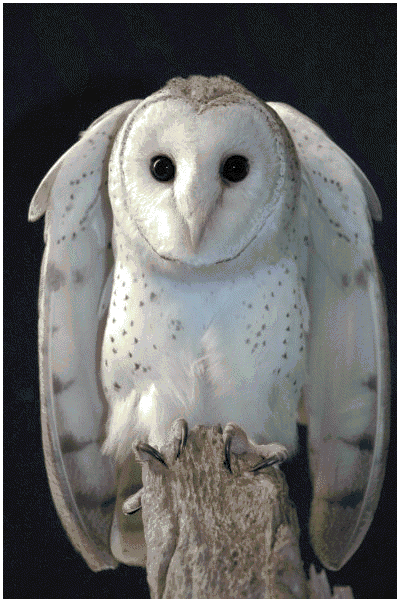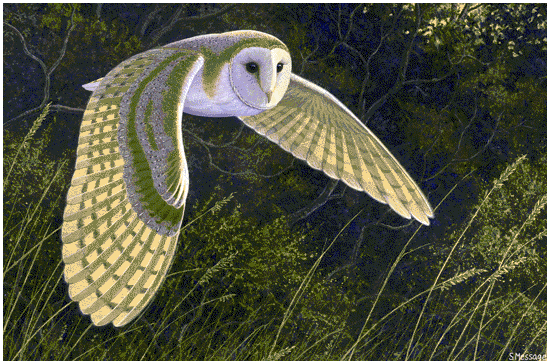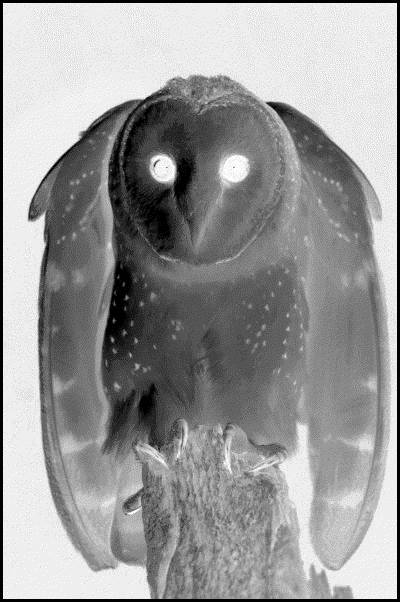David Chandler
(Firefly Books)

First off, according to Chandler, they get off on eating rats, voles, shrews, scorpions, kookaburras (sic), spiders, trogons (who?) and rats and mice. And they don't just tear them apart: When the Barn Owl catches a mouse, it "just swallows it head-first ... no dainty small bites."
-
Not only are their table-manners deplorable [we continued], their accommodations are vomit-inducing. The Screech Owl will typically have a nest filled up with various types of garbage. "The bottom of an owl's nest makes a nice home," says Ms. Berger, although we believe the word "nice" should be considered relative. "It's a messy mulch of its own feces, coughed up owl pellets, and the remains of prey such as mice and beetles."
Ants and fly maggots move in to feed on this, so it becomes a stinkpot cafeteria. "To make it even more vile," we wrote, "some owls bring home Texas blind snakes --- live ones --- who, once in the nest, defecate and release
- a noxious, smelly liquid, then writhe so that the slippery mess coats their small bodies."
David Chandler only confirms our hesitation in embracing the common owl. He says that one of their main byproducts are "owl pellets." These consist of old meals, regurgitated from the belly of the beast and left on the nest floor to fester.
He reports that "poking around in pellets is a fascinating business." Well, perhaps for him. I'm not so sure about the rest of us. For those into regurgitation, there are visual close-ups of these, but if you are checking out Owls at snack time, you might want to come back for a fuller viewing later on.
There seems to be some fairly intense research into the size, shape, and contents of these ghastly objets d'arte, and at the end of the chapter, there is a minute dissection of them by date. "Fresh out of the owl" is "Soft, squidgy and steaming!" (my Webster's seems to have misplaced the word "squidgy.") At "12 months plus," we find that the pellet has adopted a whole new life-style: "Clothes moth caterpillars hatch in the pellet, eat the fur and leave the bones." Bringing to mind ... to my mind, anyway ... a favorite song from my youth:
- Save the bones for Henry Jones
'Cause Henry don't eat no meat!

Evidently, when courting, the male Barn Owl will rustle through his collection of left-overs in his nest and present the light of his life with a partially-decayed mouselet, which she will then hold lovingly in her beak as he does his business with her. "She usually grips it in her bill during coition and gulps it down afterwards," but "If she is not hungry, she puts the item to one side instead."
Finally, if you think that all owls are hooters, you're wrong. "One thing they do not do is hoot," says our author. Their vocal repertoire is more diverse than that,
- including twitters, chirrups, hisses, squeaks, clicks, and perhaps best known of all, some impressive screeches and snores.

- It translates into "I'm here" and "go and get some food..."
which is Herb's precise way of communicating certain needs with me. Especially around cocktail time. The only thing he lacks, apparently, is a pair of wings and an insatiable appetite for voles and shrews.
If you are still interested in Tyto alba after all this, there are some fascinating facts, including that one of the primary researchers on the study of owl pellets is David Glue; that barn owls can live up to thirty-four years; that there are probably 5,000,000 of them in the world; that when they fly, they can be seen "tumbling," "ascending," "descending," and "jinking" whatever that may be; and sometimes when they are not eating shrews and rats, they eat each other. There are well over a hundred photographs in Barn Owls ... and outside of the three or four of vomit pellets, they are stunningly beautiful.